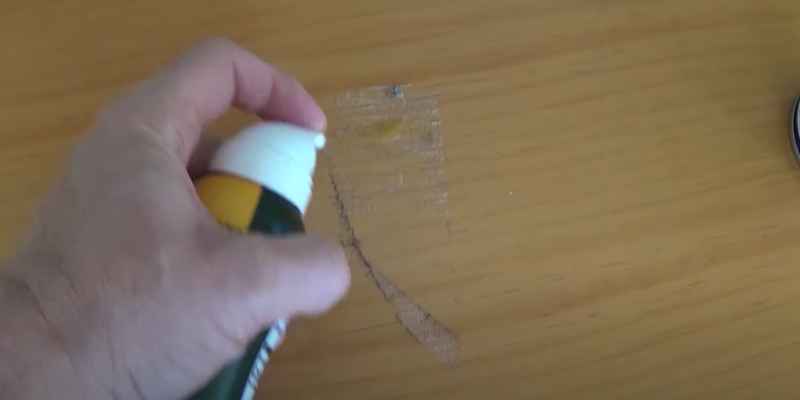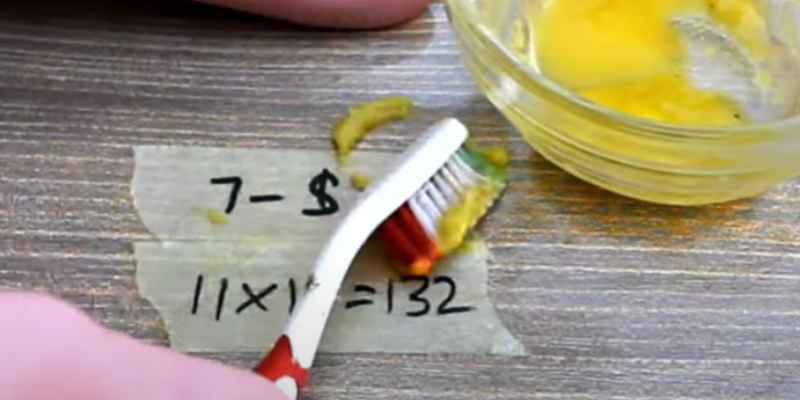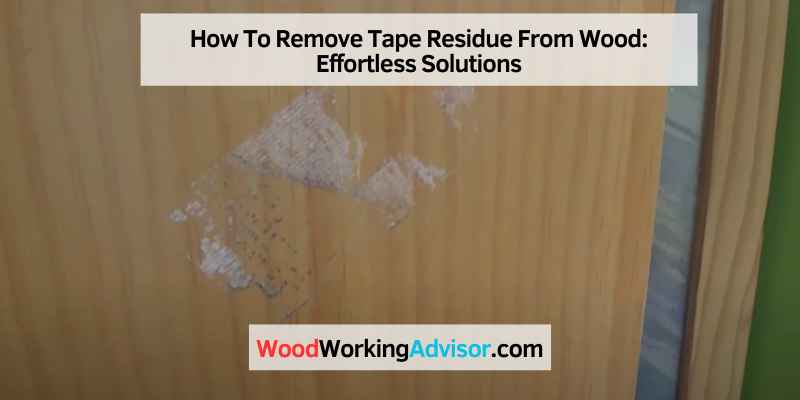To remove tape residue from wood, apply rubbing alcohol or white vinegar to a cloth and gently rub the affected area. This will effectively dissolve the residue without damaging the wood’s surface.
Having tape residue on wood can be a frustrating problem, especially if you want to restore the wood’s natural appearance. Whether it’s leftover adhesive from tape or sticky residue after removing stickers, it’s important to find a safe and effective solution to remove it.
Fortunately, there are simple methods that can be used to tackle this issue. We will discuss how to remove tape residue from wood using common household items. By following these steps, you can restore the beauty of your wood surfaces without causing any damage.
Understanding The Problem
Learn how to effectively remove tape residue from wood with these easy and practical tips. Say goodbye to sticky and unsightly marks on your wooden surfaces with these proven solutions.
When it comes to removing tape residue from wood, it’s important to first understand the problem at hand. Tape residue refers to the sticky or adhesive residue that is left behind after removing tape from wood surfaces. While tape can be a useful tool for many purposes, such as securing items or protecting surfaces, it can also leave behind an unsightly and stubborn residue. This residue can not only mar the appearance of the wood but can also attract dust and dirt over time, making it even more difficult to clean. Therefore, it is essential to know how to effectively remove tape residue from wood and restore its natural beauty. In this article, we will explore what tape residue is, why it is a problem, and the common types of tape residue that can be found on wood surfaces. So, let’s dive in and get rid of that sticky situation!
What is tape residue and why is it a problem?
Tape residue is the sticky substance that remains on wood surfaces after tape has been removed. It is often composed of the adhesive used in the tape, as well as any dirt or dust that has collected on the tape over time. This residue can be sticky, gooey, or even hardened, depending on the type of tape and how long it has been in place. The problem with tape residue on wood is that it can be difficult to remove and can leave unsightly marks on the surface. Not only does this diminish the aesthetic appeal of the wood, but it can also create a rough or uneven texture that can be unpleasant to touch. Moreover, the residue can attract additional dust and dirt, making it an ongoing source of frustration. That’s why it’s crucial to address tape residue promptly and effectively.
Common types of tape residue on wood
Different types of tape can leave various residues on wood surfaces. Understanding the common types of tape residue can help you choose the right method for removal and ensure the best possible outcome. Here are a few common types of tape residue you may encounter when dealing with sticky situations on wood:
1. Adhesive Residue: This type of residue is left behind by general-purpose adhesive tapes, such as masking tape or duct tape. It can be sticky or hard, depending on the age of the tape.
2. Double-sided Tape Residue: Double-sided tape is commonly used for mounting objects to wood surfaces. When removed, it often leaves behind a sticky residue that can be especially challenging to remove.
3. Packing Tape Residue: Packing tape is commonly used for securing packages or boxes. The adhesive used in packing tape can leave behind a stubborn, sticky residue on wood surfaces.
By identifying the type of tape residue you are dealing with, you can choose the most effective method for removal and restore the natural beauty of your wood surfaces. In the following sections, we will explore different techniques and solutions to eliminate tape residue from wood. Stay tuned!

Preparation
Before removing tape residue from wood, it’s important to prepare properly. By gathering the necessary supplies and cleaning the surface thoroughly, you can ensure a successful removal process without damaging the wood. Let’s explore each step in detail.
Gathering The Necessary Supplies
Before you begin removing tape residue from wood, gather the following supplies:
- A soft cloth or sponge
- Water
- Dish soap
- Isopropyl alcohol
- Cotton swabs
- A plastic scraper
- Mineral spirits
- Paper towels
Having these supplies at hand will make the process easier and more efficient.
Cleaning The Surface Before Removing Residue
Before tackling the tape residue, it’s crucial to clean the wood surface surrounding the affected area. Follow these steps:
- Moisten a soft cloth or sponge with water.
- Add a small amount of dish soap to the cloth or sponge and gently clean the wood surface.
- Rinse the area with clean water and dry it thoroughly with a paper towel.
This simple cleaning step helps remove any dirt or debris that may hinder the effectiveness of the residue removal process.
With your supplies gathered and the surface cleaned, you’re now ready to move on to the next step: removing the tape residue from wood.
Methods For Removing Tape Residue
Tape residue left behind on wood surfaces can be stubborn and unsightly. Luckily, there are effective methods available to remove this residue without damaging the wood. Whether you prefer using heat, natural solvents, or commercial adhesive removers, there is a solution for every preference and budget. In the following sections, we will explore three of the most common methods for removing tape residue, so you can restore the beauty of your wood effortlessly.
Using Heat To Loosen The Residue
One effective way to remove tape residue from wood is by using heat to soften and loosen the sticky adhesive. To do this, follow these simple steps:
- Plug in a hairdryer and set it to a low heat setting.
- Hold the hairdryer about six inches away from the residue.
- Mov the hairdryer back and forth over the residue in a sweeping motion for about 30 seconds to heat up the adhesive.
- Gently peel off the tape using your fingers or a plastic scraper.
- If any residue remains, repeat the process until all adhesive is removed.
Applying Natural Solvents
If you prefer a more natural approach, you can use household ingredients as solvents to dissolve tape residue. Here is a simple homemade solution to try:
|
Ingredients:
|
Instructions:
|
Note:
|
Using Commercial Adhesive Removers
If you prefer a hassle-free solution, commercial adhesive removers are readily available in stores. These products are specifically designed to safely and effectively dissolve sticky residue without harming the wood. When using a commercial adhesive remover, follow these steps:
- Read the instructions on the product carefully before applying.
- Apply a small amount of the adhesive remover to a clean cloth or sponge.
- Gently rub the residue in a circular motion until it begins to dissolve.
- Wipe away the residue with a clean cloth.
- If any residue remains, repeat the process until the wood surface is clean.
- Wash the wood surface with mild soap and water to remove any residue from the adhesive remover.
- Dry the wood thoroughly with a clean cloth.
By utilizing heat, natural solvents, or commercial adhesive removers, you can easily remove tape residue from wood surfaces. Choose the method that best suits your preferences and follow the steps carefully to ensure a successful outcome. With these effective techniques, you can restore the natural beauty of your wood and enjoy a residue-free finish.
Step-by-step Process
Learn how to effectively remove tape residue from wood in a step-by-step process. This guide provides simple, easy-to-follow instructions for restoring your wooden surfaces to their original condition.
Removing tape residue from wood can be a tedious task, but with the right approach, you can restore your wood surfaces to their former glory. By following this step-by-step process, you can effectively remove tape residue from wood without causing any damage.
Step 1: Testing The Removal Method On A Small Area
Before diving into the removal process, it’s crucial to test the chosen method on a small, inconspicuous area of the wood surface. This will help ensure that the method doesn’t cause any discoloration or damage to the wood.
Here’s how to test the removal method on a small area of the wood surface:
- Select a small, hidden area of the wood that won’t be noticeable.
- Apply a small amount of the chosen removal method onto a cloth or cotton ball.
- Gently rub the cloth or cotton ball on the designated area in a circular motion.
- Observe the area for any adverse reactions, such as discoloration or damage.
- If there are no negative effects, proceed to the next step. If there are adverse reactions, consider trying a different method or seeking professional help.
Step 2: Applying The Chosen Method To The Residue
Once you’ve confirmed that the removal method is safe for your wood surface, it’s time to apply it to the tape residue. There are various methods you can choose from, such as using heat, solvents, or natural remedies like vinegar or olive oil.
To apply the chosen method to the tape residue, follow these steps:
- Prepare all the necessary tools and materials, including the removal method and a clean cloth or sponge.
- Dampen the cloth or sponge with the removal method, ensuring it is not soaked.
- Gently press the cloth or sponge onto the tape residue, allowing the method to penetrate and soften the residue.
- Let the removal method sit on the residue for a few minutes to ensure its effectiveness.
Step 3: Scrubbing Or Scraping Off The Softened Residue
After giving the removal method enough time to work its magic, it’s time to remove the softened residue from the wood surface. Depending on the nature and thickness of the residue, you may need to scrub or scrape it off.
Here’s how to scrub or scrape off the softened residue:
- Using a soft-bristled brush or a plastic scraper, gently scrub or scrape off the residue.
- Be cautious not to apply excessive force, as it may cause damage to the wood surface.
- Continue scrubbing or scraping until all the residue is removed.
Step 4: Cleaning And Drying The Wood Surface
Once you’ve successfully removed the tape residue from the wood surface, it’s essential to clean and dry the area properly to prevent any remaining residue from causing further damage. This will also help restore the shine and luster of the wood.
To clean and dry the wood surface, follow these steps:
- Dampen a clean cloth with mild soap and water.
- Gently wipe down the area to remove any remaining residue or cleaning solution.
- Rinse the cloth thoroughly and wipe down the area again to ensure all residue is removed.
- Dry the wood surface with a clean towel or allow it to air dry completely.
By following this step-by-step process, you can effectively remove tape residue from wood surfaces and restore their natural beauty. Remember to always test the removal method on a small area first, choose the appropriate method, and handle the wood surface with care throughout the process.

Preventing Tape Residue On Wood
Tape residue on wood can be a frustrating problem, leaving unsightly marks and sticky residue that can be difficult to remove. Fortunately, there are a few simple steps you can take to prevent tape residue from forming on your favorite wooden items. By using alternative methods to secure items and applying a protective finish on the wood, you can keep your wood surfaces free from tape residue.
Using Alternative Methods To Secure Items
Instead of relying solely on tape to secure items to your wooden surfaces, consider using alternative methods that can minimize the chances of tape residue. One option is to use removable adhesive putty or mounting squares. These products provide a strong hold but can be easily removed without leaving any sticky residue behind. Another option is to use painter’s tape or masking tape, which is designed to be easily removed without causing any damage or residue. These alternative methods can help you avoid the hassle of tape residue.
Applying A Protective Finish On The Wood
Another effective way to prevent tape residue on wood is by applying a protective finish. A protective finish creates a barrier between the tape and the wood surface, reducing the likelihood of any residue sticking to the wood. There are several types of protective finishes available, including wax, varnish, or polyurethane. Before applying the protective finish, make sure to clean the wood surface thoroughly and remove any existing tape residue. Then, follow the manufacturer’s instructions to apply a thin and even coat of the protective finish onto the wood. Allow it to dry completely before using tape on the surface. This extra layer of protection can help prevent tape residue from forming and make any potential cleanup much easier.
Conclusion
To summarize, removing tape residue from wood can be a simple process if you follow the right techniques. Whether you’re dealing with adhesive residue from packing tape or sticky residue from tape used in crafts, using common household items like vinegar, rubbing alcohol, or even mayonnaise can help get the job done.
Just remember to test any product on a small, inconspicuous area first and be patient with the process. With these tips, you can restore your wood surfaces to their original clean and pristine condition.


